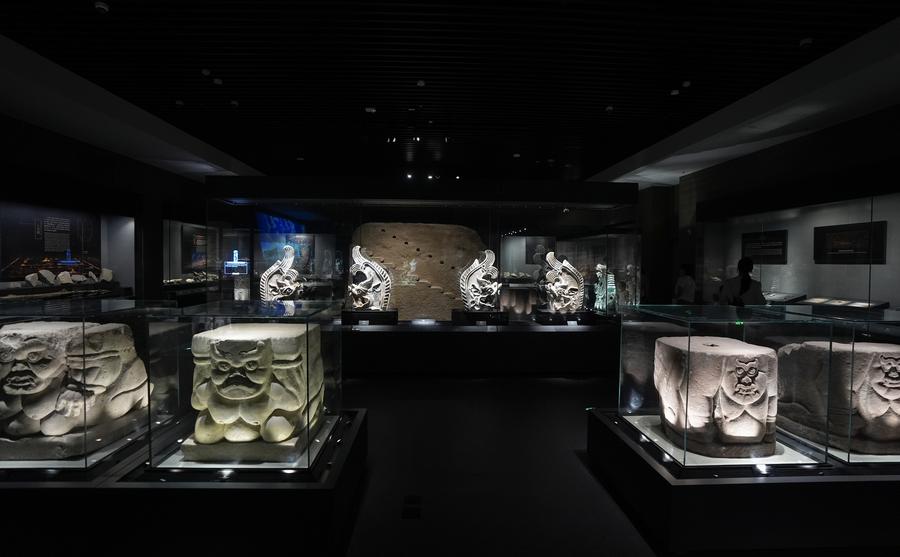
A Xixia Imperial Mausoleum in Yinchuan, Ningxia Hui Autonomous Region in northwest China, July 10, 2025. /Xinhua
Editor's note: David Gosset, a special commentator for CGTN, is a specialist in global affairs and sinology and the founder of the China-Europe-America Global Initiative. One of his notable publications is an annual report on Chinese museums. The article reflects the author's opinions and not necessarily the views of CGTN.
UNESCO's recognition of the Xixia Imperial Mausoleums as a World Heritage Site marks a significant achievement for Chinese culture. This honor is not only a proud moment for the nation, but also a milestone that has excited sinologists and scholars across the globe. The UNESCO World Heritage status is a testament to the importance of the mausoleums, as well as the broader achievements in Chinese archaeology. This recognition highlights the immense value of preserving and understanding the rich cultural and historical legacy of China, which has often been a beacon for world heritage.
The mausoleums, located in the Ningxia Hui Autonomous Region in northwest China, stand as a monumental symbol of China's dynastic past. Built over 900 years ago during the Xixia Dynasty (1038-1227), they represent the culmination of a unique culture that flourished in the region. These final resting places of the emperors and nobles of the dynasty are a marvel of architecture and artistry, embodying the ancient traditions and customs of the Xixia people. The UNESCO designation ensures that these historical sites will be preserved for future generations, enabling visitors from around the world to witness the grandeur of Chinese civilization firsthand.
The mausoleums present an awe-inspiring external appearance, blending architectural grandeur with the natural beauty of the surrounding landscape. Their unique structure combines elements of traditional Chinese architecture with influences from Tibetan and Central Asian styles, revealing the coexistence and integration of diverse cultures in the region. They are typically pyramid-shaped, with tiered platforms rising gradually to a central peak, creating a striking silhouette against the sky.
Constructed from stone and earth, the tombs are often surrounded by protective walls and large stone steles with intricate carvings and inscriptions that detail the lives of the emperors and their families. Many of the structures are adorned with ornate sculptures, including symbolic animals and guardian figures, which reflect the spiritual beliefs and customs of the Xixia Dynasty. Set amidst the arid, rolling hills of Ningxia, the mausoleums' earthy tones blend seamlessly with the desert landscape, giving the entire complex an air of solemnity and mystery.

The Xixia Imperial Tombs Museum in Yinchuan showcases cultural relics from the Xixia Imperial Mausoleums, July 9, 2025. /Xinhua
The UNESCO inclusion is a reflection of the cultural renaissance that China is experiencing. In recent years, China has made a concerted effort to preserve its cultural heritage while simultaneously embracing the future with open arms. This delicate balance between honoring the past and looking forward to the future is what makes China's present so dynamic. It is not only preserving its ancient monuments and traditions, but is also embracing new technologies, modern infrastructure, and innovative policies that make it a global leader in many fields. The Xixia Imperial Mausoleums’ inscription on the UNESCO list is a perfect example of this balance – China is safeguarding its cultural heritage while making strides toward future development.
The inclusion will also have a profound impact on Ningxia, which has long been a crossroads of various cultures and will now undoubtedly see an increase in cultural tourism. Tourists from around the world will be drawn to this historically significant area, eager to learn about the Xixia Dynasty and its cultural contributions. The mausoleums, along with the region's other historical sites, will provide a deeper understanding of China's diverse cultural landscape, making it an important stop for anyone seeking to explore the ancient civilizations of Asia.
China's focus on cultural tourism is evident in its recent changes to visa policies. As the country opens up to international tourism in ways not seen before, new visa regulations are making it easier for foreign visitors to experience China's rich cultural heritage. This shift is part of a broader effort to promote China as a global destination for tourism, and the Xixia Imperial Mausoleums will undoubtedly play a role in that initiative. The combination of an increasing interest in Chinese culture, improved accessibility and enhanced preservation efforts makes this the perfect time for the world to discover the wonders of China.
For sinologists and Chinese history experts, the UNESCO designation is also a recognition of their long-standing efforts to study, protect and promote Chinese cultural heritage. Scholars have worked tirelessly to uncover the history of the Xixia Dynasty, and their contributions have been instrumental in preserving the mausoleums. The UNESCO recognition not only celebrates these efforts but also shines a spotlight on the importance of academic research in understanding and safeguarding the world's cultural treasures.
On a larger scale, this event serves as a reminder of the importance of cultural preservation in a rapidly changing world. In an era marked by globalization and technological advancement, it can be easy to overlook the importance of maintaining connections with our history and heritage. However, China's efforts to protect its cultural landmarks show that the past and the future are not mutually exclusive. They can coexist and enrich one another, creating a vibrant cultural present that is both rooted in tradition and open to the future.
(If you want to contribute and have specific expertise, please contact us at opinions@cgtn.com. Follow @thouse_opinions on X, formerly Twitter, to discover the latest commentaries in the CGTN Opinion Section.)
阅读原文:https://news.cgtn.com/news/2025-07-12/UNESCO-nod-to-Xixia-Imperial-Tombs-Legacy-and-progress-1EWD5gXoMbC/p.html